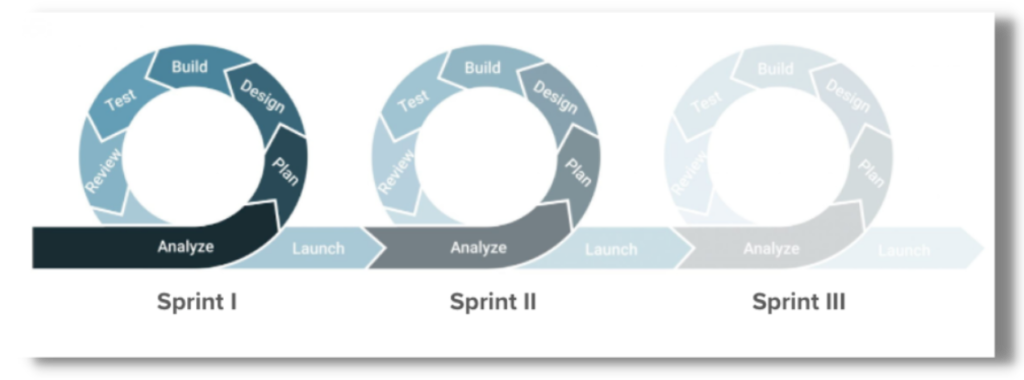What is Asynchronous Video?

Asynchra–wha? Asynchra–who? What is Asynchronous Video? Basically, it includes any video-based recording that is not live-streamed or happening in real-time, as opposed to an on-the-spot video call or meeting. If you’ve ever emailed or instant messaged (IM’d) someone, you’re no stranger to asynchronous forms of communication — that is, communications that do not require an immediate response from the recipient. Asynchronous Video allows people the ability to respond to or begin a conversation by recording video on their own time.
How is asynchronous video different from synchronous video?
Since the term “synchronous video” is not a part of the common vernacular, it’s easy to misunderstand the term’s fairly simple meaning. Synchronous videos are essentially videos created in real-time – for example, at an online, virtual meeting through a platform like Zoom or Teams. Whereas asynchronous videos can be accessed and viewed at any time as well as multiple times, synchronous videos allow viewers to only see the same video at the same time.
There are benefits and drawbacks to both forms of video communications. If the end goal of using either mode is to cut down on time and communicate more effectively, both types of video communications could be used, depending upon the context and circumstance. For example, if team members at the same workplace are trying to cut down on virtual, synchronous meeting time, they can instead use asynchronous video to pre-record presentations, cutting down on time spent sitting in a group to hear every presentation all at once. However, if the team completely replaces virtual meetings with asynchronous video, team members may become overwhelmed by their inboxes, flooded with too many pre-recorded videos — creating more administrative burden rather than saving time.

How are asynchronous videos used?
Here are just a few examples of how asynchronous video is currently being used across different types of organizations and within different frameworks:
- In the workplace: As mentioned, to replace Zoom, Teams, Webex or other video-based meetings so that coworkers can hear each other’s presentations at their own pace rather than sitting in on a group video call. This can save workers’ time and capacity to take on more tasks. In addition, HR managers may find that onboarding and training employees is easier with pre-recorded, asynchronous how-to videos.
- In colleges and other learning environments: To share pre-recorded lectures, how-to’s or other explanatory videos that students can view on their own time. In addition, educators can give students feedback on assignments, or allow students to give progress reports as needed.
- In healthcare: To allow patients to give updates on their health in place of in-person wellness check-ins and visits. This can give patients with minor symptoms the ability to stay home and rest — or allow those in quarantine to check in during isolation — to get the care they need remotely, and give healthcare practitioners more time to make diagnoses.
- In social media: To communicate with and entertain social media users’ friends and other followers, through platforms such as TikTok, YouTube, Instagram, Weibo, and others. Asynchronous video is one of the most effective ways that social media influencers connect with their audiences and build their personal brands.
- In market research: To allow participants to provide video-based survey responses, submit video diaries, give quick feedback during shop-alongs, and more. This is also commonly referred to ‘unmoderated feedback’ as opposed to live, moderated feedback. To learn more about these two customer feedback methods and how they are used in User Experience (UX) research, read our post about unmoderated usability testing.
Asynchronous video responses can also be incorporated into live and moderated market research projects using consumer insights platforms like Discuss. Learn more about Discuss Self Captures for unmoderated, customer-driven feedback.
What are the key benefits of asynchronous videos?
Whether asynchronous video is shared in the workplace, at school, in the doctor’s office or elsewhere, there are many reasons why people may choose this mode of communication, including:
- To allow viewers to learn or take in responses on their own time, allowing more flexibility in their schedule.
- To allow those capturing asynchronous video the ability to answer a question or present information in a specific place and time of their choosing.
- To present contextual examples of information to bring survey responses to life.
- To allow viewers a chance to pause and improve their absorption of the information that is being viewed.
- To allow viewers to speed up an explainer video or presentation to absorb information at a faster pace.
Conclusion
People utilize asynchronous video and communication for a number of reasons, and the values are becoming more apparent as people look to find more alternatives to synchronous video modes of communication. From lecture halls to doctor’s offices, people are becoming more comfortable utilizing such videos alongside other asynchronous communication channels like email and instant messaging — especially the ‘TikTok generation’ that take self-captured video as an everyday means of communicating to their audiences. Marketers have already seized upon User Generated Content (UGC) from places like TikTok, Instagram and YouTube, leveraging asynchronous customer videos for promotional purposes. Market researchers are beginning to follow their lead (Forbes).
And as the scales continue to tip further towards video-based meetings rather than in-person meetings, many are already finding that on-the-spot, synchronous video conferencing can have many drawbacks — “Zoom fatigue” and burnout being chief among them. Where synchronous video can create friction for workers and others, asynchronous can fill the gap.
At Discuss, we’ve added our asynchronous video feature for unmoderated customer feedback, Self Captures, in response to the growing need for CX, UX and insights teams to find even more ways to engage and understand their target audiences.
Start a Free Trial with Discuss Self Captures and see how asynchronous videos can benefit your organization to turn experiences into insights.
Sign Up for our Newsletter
Related Articles

Agile Approaches to Consumer Insights
Think about which companies you know that have been able to adapt to change most rapidly. Chances are that the
Think about which companies you know that have been able to adapt to change most rapidly. Chances are that the

From Observation to Insight to Strategy: The Evolution of Innovation
Many people think that innovation starts with the proverbial “big idea,” the imaginary bulb that lights up above an inventor’s…
Many people think that innovation starts with the proverbial “big idea,” the imaginary bulb that lights up above an inventor’s…

Maximize the number of research projects completed by year’s end: Yes, it can be done
Ask most agencies managing enterprise-level market research (MRX) projects, and they’ll tell you they have a love/hate relationship with their…
Ask most agencies managing enterprise-level market research (MRX) projects, and they’ll tell you they have a love/hate relationship with their…


